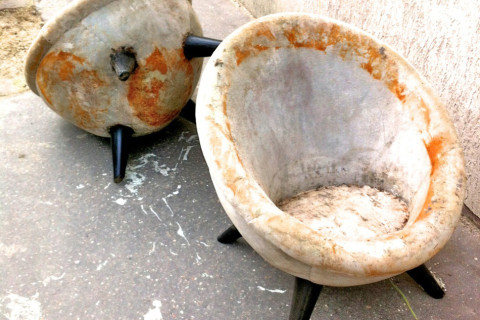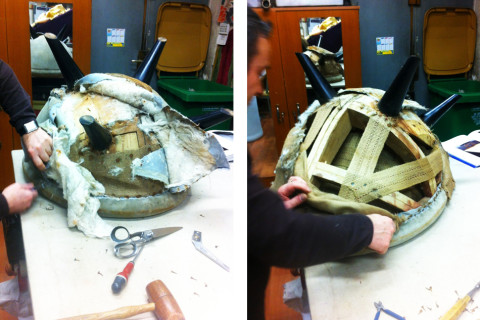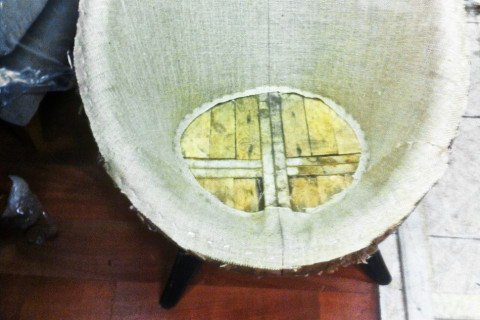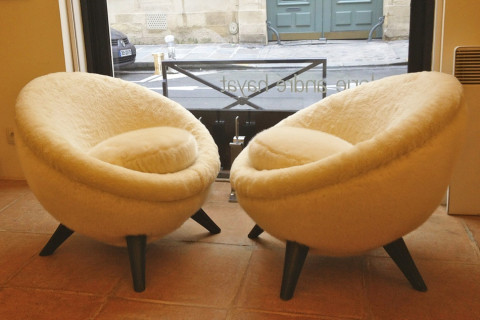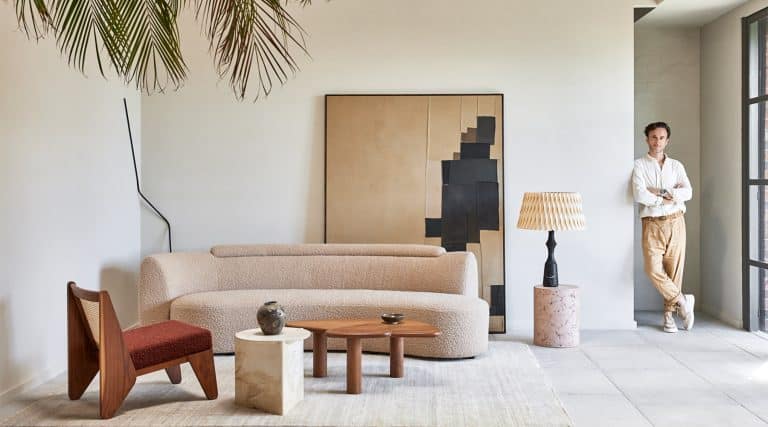
May 2013“Furniture must be functional as well as aesthetic,” says Hayat.
“That’s what I love about Americans. They ask, ‘Can I sit in it?’ Then, even if the piece is beautiful, if it’s not comfortable, it’s finished.”
A well-known Parisian dealer André Hayat might have an avuncular air, his glasses perched on his nose. Yet when he’s on the trail of his 20th-century furniture coups de coeur, there is no hunter more eagle-eyed and energetic.
“What I love about this business is the reality of finding something marvelous at five o’clock in the morning on a sidewalk,” he confides, his eyes twinkling. “Did you know that one month ago there was a pair of signed Jean-Michel Frank armchairs left abandoned in the sixteenth arrondisement? Now they are in a big gallery for a rich price,” he says. “This is what can happen in France. We are the attic of antiques.”
Hayat opened his gallery four years ago on the Left Bank’s rue de Lille — now known as the Paris destination for 20th- and 21st-century decorative arts and design. Though his exhibition space measures only 400 square feet, he meets the challenge by arranging his star pieces with aesthetic panache. The inviting array has proven a beacon to a clientele that includes such exacting Parisian interior designers as India Madhavi, Jacques Grange and Tino Zervudachi, as well as such pilgrims from the U.S. as Anthony Ingrao, Penny Baird and Bruce Bierman.
Hayat focuses on designers from the 1940s and ’50s, with an emphasis on Jean Royère, known for such iconic designs as the Ours Polaire (Polar Bear) sofa and armchairs and Oeufs (Eggs) chairs. Signature Royère pieces recently displayed in the gallery range from a signed, three-drawer solid oak desk to a witty pair of YoYo wrought-iron bar stools with white, woolly “soccer ball” seats. The designer’s rare black-and-gold indoor metal gate serves as a space-divider between the shop’s entry and main room, and, in a Goldilocks vignette, a grown-up pair of his cream-colored faux-fur Egg chairs sits opposite two petite Eggs covered in floral fabric and brown-velvet fur.
Royère is the hot ticket,” says Hayat. “Because he was a decorator, his pieces were always commissions, not manufactured. Each one was creative, different and inspirational.”

A Jean Royère black-and-gold metal gate provides a handsome divider for the snug gallery; in the foreground sit two of the designer’s Croisillon armchairs with red iron frames.

Hayat reupholstered a Theo Ruth couch and two chairs, 1950, in pale orange mohair velvet.
However, other creators pop up, too: André Sornay’s marquetry lamps here, Mathieu Mategot’s black-and-yellow Domino coffee tables there, along with Jacques Adnet’s hand-stitched leather-sheathed pair of consoles with surprising Formica tops. Also present are modernist mirrors of Hayat’s own design, whose gold-leaf glass, engraved waves, rock crystal cabochons and optical glass bubble decorations mix in brilliantly. And there is always a place for a discovery, such as the creations of unsung Dutch designer Théo Ruth.
Hayat’s debut as a dealer predates the gallery’s 2009 opening by nearly two decades. He first launched a stall in the Paris Flea Market’s Marché Paul Bert in 1990 as a flashback of sorts to his childhood in mid-century Cairo, where his French family spent two generations living as expats. In the cosmopolitan Eqyptian capital, then ruled by King Farouk, haute decoration was a way of life. At his parents’ home, it was French Art Deco; at his aunt’s, decor by the Maison Jansen. Many homes he visited were entirely decorated by Jean Royère, whose projects 4across the Middle East included the palaces of Jordan’s King Hussein, the Shah of Iran and Farouk himself. The Hayats moved to France in 1956, “but I had seen those houses and they remained in my memory,” he says.
In Paris, he went to business school, then took a job in advertising and packaging at food-giant Danone, a position he soon deserted for fashion, establishing an eponymous avant-garde knitwear company. At the same time, he explains, “I always collected for my own pleasure,” haunting London’s Portobello and all the Parisian flea markets. When his successful fashion company eventually proved too small to compete with mass distribution, he turned his hobby into a full-time occupation — what he calls “my third life: antiques.”
“Jean Royère is the hot ticket…his pieces were always commissions, not manufactured.”

Two Jean Royère chairs (from a set of eight) reupholstered in red velvet flank the designer’s signed oak desk.
Sixteen years later I started at the Flea Market, I found two Mies van der Rohe chairs on the sidewalk, again in the sixteenth,” he recalls. “Then, a young lady who had inherited some furniture she didn’t like, said, ‘Would you come and take it away?’ I was young with energy, so I went. The house was filled with Jean-Michel Frank pieces, enough to stock my stall for three years.”
Adds the veteran treasure hunter with a grin: “Beginner’s luck.”
Visit Galerie Andre Hayat on 1stdibs
TALKING POINTS
Today, Hayat especially delights in rescuing and restoring 20th-century furniture gems. “I love the smell of dust and things “dans leur jus” — in original, often dilapidated condition,” he beams. “My greatest pleasure is to strip these old Oeuf chairs, Royère’s wittiest design in my opinion. Although they look small, the are comfortable even for large people.” Here, Hayat illustrates the restoration process with before, during and after photos.

